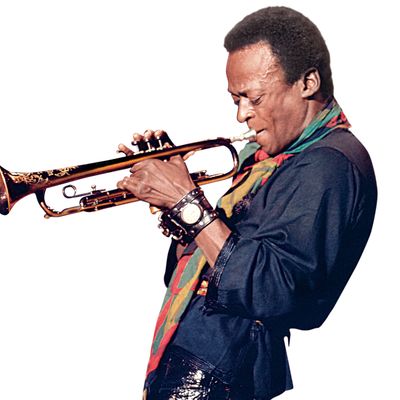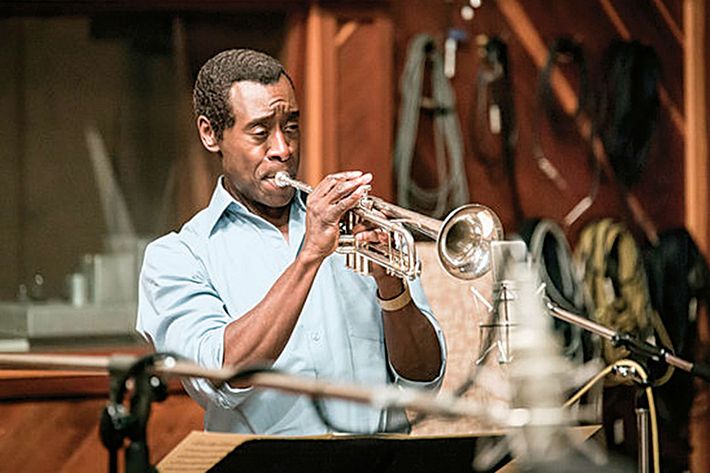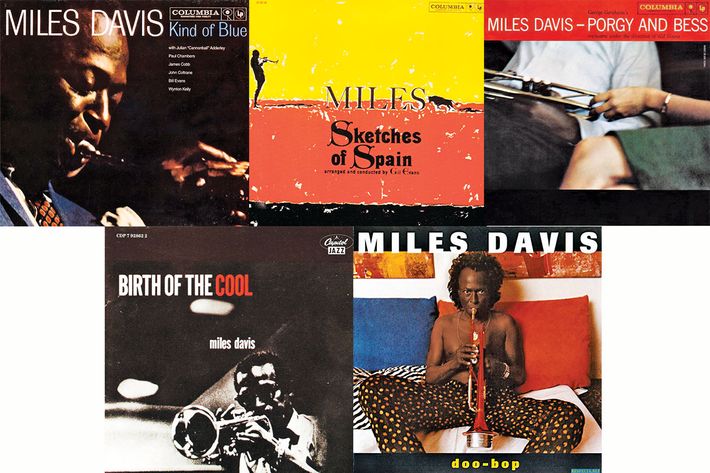
When Miles Ahead, directed by and starring Don Cheadle, premieres at the New York Film Festival in October, it’ll mark the first time that the jazz genius Miles Davis has been the subject of a non-documentary film. It wasn’t a lack of interest that has kept Davis from movie theaters till now. Nor was it lack of material: Davis, who died in 1991, lived a dynamic and controversial life, both personally and musically. (Multiple biopics wound up in development hell.) Cheadle’s film focuses on a period when the trumpeter was living in seclusion, so here’s a broader overview of one of American music’s true giants.
1. What to Know About His Sound
Grammy-nominated trumpeter and jazz educator Jon Faddis explains:
“The thing that is special about his sound is economy when he was improvising. Before Miles, most people thought of the trumpet as a very extroverted instrument. Miles was more introverted in his approach. He used a Harmon mute — it wasn’t really popular before he started to use it — and it’s a very beautiful sound. I also think his minimal use of vibrato was a tremendous influence on instrumentalists. Recordings like ‘ ’Round Midnight,’ ‘Someday My Prince Will Come,’ ‘I Thought About You’ were ingenious. And one of the things that set Miles apart was his use of space, making the space a part of the music. Before Miles came on the scene in the 1940s, we had players who were more technically proficient, but he really didn’t have the technique at that time to play like a Dizzy Gillespie, so he wanted to go in a different direction. He developed in a way that suited his cool persona. When you listen to Miles, it feels like you get to know the person. You hear in the music: ‘This is who I am. Check it out.’ ”
___________
2. Milestones
1926: Born on May 26, in Alton, Illinois, to a homemaker mother and dental-surgeon father.
1943: While a student at East St. Louis Lincoln High School, begins performing in local bands, earning $75 to $80 a week.
1944: Hears Dizzy Gillespie and Charlie Parker perform, which he later calls the greatest moment of his life “with [his] clothes on.” Moves to New York to attend Juilliard.
1945: First recording date, with Herbie Fields for Savoy Records. Drops out of Juilliard. “If I stayed any longer,” he said, “I was going to have to play like a white man.”
1946: First uses Harmon mute on his trumpet in an effort to sound less like Gillespie.
1948: Dexter Gordon tells him to dress more “hip.” Miles begins his sartorial fixation.
1949: Travels to Paris, where he meets Juliette Greco. Leaves Paris and Greco, becoming depressed and beginning a heroin addiction.
1950: Meets John Coltrane. Arrested for drug possession; acquitted in January 1951.
1953-54: Kicks heroin, starts going to the gym and practicing boxing, which he’ll do for the rest of his life.
1955: Coltrane joins Miles’s first Great Quintet. Davis has throat polyps removed; damages vocal cords while recovering and develops hoarse speaking voice.
1957: Birth of the Cool is released and is considered the first “cool jazz” album.
1959: Records Kind of Blue, the definitive modal-jazz album. Beaten by a policeman outside Birdland. The event “made me bitter and cynical again …”
1960: Marries dancer Frances Taylor in December. Their marriage lasts for eight years.
1963–64: Forms second Great Quintet, with whom Miles forges a new style based on “time, no changes,” emphasizing democratic interplay.
1966–67: Meets future wife Cicely Tyson. Coltrane dies. Begins adding electric elements into his music.
1968: Dates Betty Mabry, who appears on the cover of Filles de Kilimanjaro. (The two marry that same year.) Makes drastic changes to band including hiring three keyboardists.
1970: Releases Bitches Brew, which ushers in jazz’s fusion era, during which musicians experiment with rock.
1972: Releases the Sly Stone–and–James Brown–influenced On the Corner.
1975–80: Enters a period of seclusion in which he barely picks up his trumpet and struggles with drug use.
1981: Marries Tyson at Bill Cosby’s house on Thanksgiving. Releases The Man With the Horn, his first new album in six years.
1985: Releases You’re Under Arrest, featuring his versions of Cyndi Lauper’s “Time After Time” and Michael Jackson’s “Human Nature.”
1987: Meets Ronald Reagan. Hates Ronald Reagan. (“Nancy is the one who [had] the charm.”)
1991: Dies at 65 as a result of pneumonia, respiratory failure, and a stroke in Santa Monica, California, on September 28.
___________
3. Don Cheadle Picks Five Albums

Porgy and Bess (1959)
“I love that it was theatrical, but so hip. There are people that think it’s square music. I think it’s beautiful.”
Kind of Blue (1959)
“Instead of being vertical like bebop, here the modal musical landscape became horizontal.”
Bitches Brew (1970)
“This helped a lot of young people find their way to Miles’s earlier music — sort of a gateway.”
Circle in the Round (Compilation, 1979)
“He took the music he did with Herbie [Hancock] and Tony [Williams] and Wayne [Shorter] as far as it could go.”
We Want Miles (1982)
“The music felt aspirational, like it was reaching out for something, leaning forward.”
___________
4. The LPs People Buy*

1. Kind of Blue (1959): 3,495,572 copies sold
2. Sketches of Spain (1960): 861,000 copies sold
3. Porgy and Bess (1959): 286,000 copies sold
4. Birth of the Cool (1957): 280,000 copies sold
5. Doo-Bop (1992): 276,000 copies sold
*According to Nielsen Soundscan.
___________
5. Where to See Him Onscreen
Miami Vice (1985)
Davis guested on the hot-cop show as a bordello owner. “Playing a pimp was easy,” he recalled, “because there’s a little of that in every man.”
Scrooged (1988)
In this retelling of A Christmas Carol, which starred Bill Murray, Davis is glimpsed briefly as a street musician playing “We Three Kings.”
Dingo (1992)
Davis’s only feature-film role; he played a jazz trumpeter, Billy Cross, who takes an aspiring musician under his wing after the two meet in Australia.
___________
6. Life After Death
Albums released under his name while he was alive: 42
Albums released under his name since his death, 24 years ago: 63
___________
7. Musicians Miles Called a “Motherfucker”
And meant it in a good way:
Cannonball
Adderley
Louis Armstrong
Count Basie
Nat “King” Cole
John Coltrane
Jack DeJohnette
Duke Ellington
Michael Jackson
Elvin Jones
John McLaughlin
Charles Mingus
Charlie Parker
Bud Powell
Prince
Carlos Santana
Frank Sinatra
Bessie Smith
Sarah Vaughan
And meant it in a bad way:
Steve Miller*
*“At the Fillmore East in 1970, I was opening up for this sorry-ass cat named Steve Miller … so I’m pissed because I got to open for this non-playing motherfucker just because he had one or two sorry-ass records out. So I would come late and he would have to go on first, and then when we got there, we just smoked the motherfucking place and everybody dug it!”
___________
8. In His Own Words:
On his music: “I have to play the way I want to play, because that’s the only way I can feel like something, you know.”
On his albums: “I don’t keep any of my records. I can’t stand to hear them after I’ve made them.”
On Jazz: “Jazz is an Uncle Tom word. They should stop using that word … just [call it] music, man.”
___________
9. What’s Controversial?
Davis was aggressively outspoken about racism when few were, and his habit of performing with his back to the audience was seen as dismissive. His use of rock and funk rhythms and electric instrumentation led hidebound jazzbos to accuse him of selling out. But it’s the subject of women, though, where his legacy gets dark. Davis admitted to having “slapped the shit out of” his third wife, actress Cicely Tyson. His first wife, Frances Taylor, told the New York Times that she “actually left running for [her] life — more than once” during their marriage. In the late ’70s, Davis hospitalized a girlfriend with a punch to the jaw. He had issues outside of relationships, too, briefly turning to pimping in the ’50s to support a heroin habit.
*This article appears in the September 21, 2015 issue of New York Magazine.




